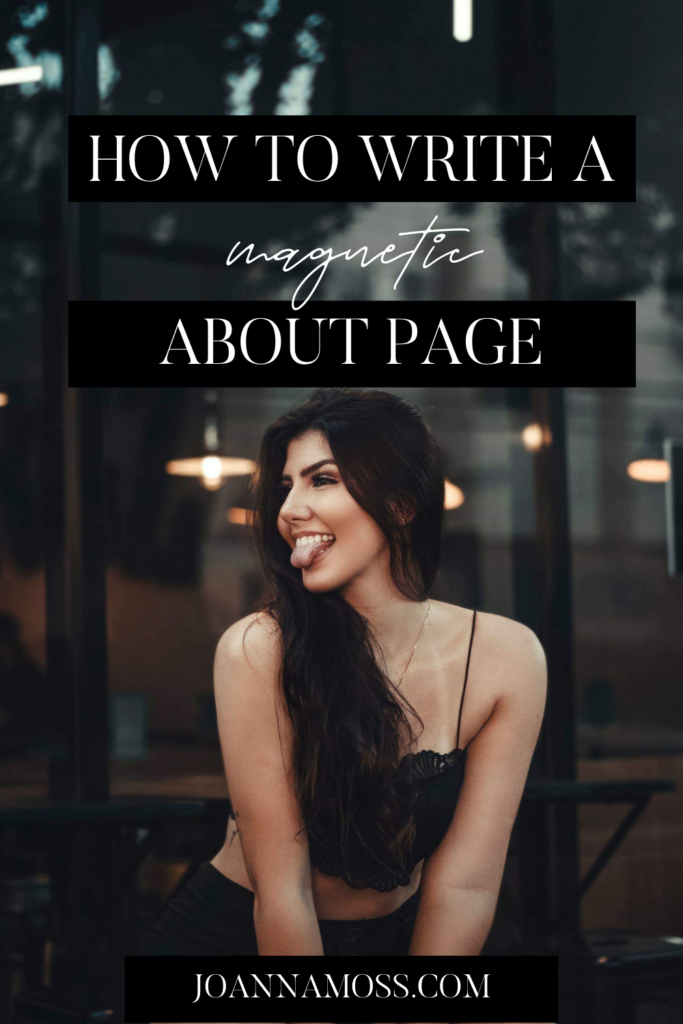The About Page is the trickiest website page to write content for. This page seems like it should be simple, right? It should just be some info about you and you’re done. Wrong! The about page should actually not be about you at all. It should be about how you are going to help your client solve their pain point. This post will walk you through how you write a magnetic about page, and 3 big mistakes to avoid on your about page.
Hook the visitor
The top of your about page should have a bold statement about who you are and what you do. This headline should hook your visitor and make them want to read more. An example of this type of statement would be “Hey! I’m Jill. Wedding photographer, unofficial maid of honor, and red wine enthusiast.”
Write it in the first person “I” & “You”
Engage with the reader by writing your About page in the first person. This will allow you to treat this page as a conversation with your visitor. Meeting someone for the first time and having a conversation with them when they speak to you in the third person would be a little strange.
Mistake to avoid: Do not use “we” on your about page unless your company is actually a team. Using the term “we” when you are a solopreneur to make yourself look bigger will just create mistrust with your visitor.
Talk about the visitor
The about page should be about your visitor, not about you. One more time for the people in the back. “The about page should be about them, not you”. It should paint a picture of how your services and experience will help them solve their pain point. Talk about who your ideal client is. You want people to know they’re in the right place, as much as you want them to know they’re not in the right place. If you are a branding photographer for fitness mompreneurs and the visitor is not a mompreneur they will know your service isn’t for them.
Mistake to avoid: When you write for everyone you are writing to no one. Be specific as to who your audience is and speak to that one audience.
Have fun with it
Adding some fun facts, a light quiz or infographics will add a magnetic element to the page. You can do this with a This or That quiz, a basic quiz of your favourite things for example. This will allow you to connect with your visitor on a more personal level. Maybe you both grew up in a small town in Oregon, or you both love dogs.
Add social proof
The about page is a great page to add testimonials. Share what other clients you’ve worked with have said it was like working with you. The testimonials on your about page should more attest to your personality, your experience and the results you delivered.
Include a Call To Action
Once you’ve introduced yourself and told the visitor how your services will greatly help them make sure to add a call to action to the bottom of the page to tell them what you want them to do next. A good progression from your about page would be leading visitors to your experience page and your portfolio, so you can show them more about the services you talked about on this page.
Mistake to avoid: Forgetting a call to action at the bottom of your About Page is something I see often. This happens when the about page is more created and written about you than your audience. You always want to be in control of how you guide your audience through your website. We do this through a call to action.
Creating Magnetic Website Content
Writing website content is not an easy task. Staring at a white page. Not knowing what to write and what section it should go. That’s why I have created the Website Content Document. The content document was created to help you write your full story brand. Written with a copywriter to offer you examples, clear prompts and fill in the blanks. This content document will help you write your website content faster and easier keeping your website project on task. Check out the Website Content Document →

Shop Tonic Website Templates
Tonic has my absolutely favorite templates in the game – their websites somehow combine killer strategy AND stunning, standout design. You're going to feel so confident in your new site!